“Save the trees so that the birds and animals will have a nice place to live.” “It is our job to protect the trees … they have been here a long time since my grandpa lived here.” “I like trees, they are beautiful.” “Trees are my best friends.” “Without trees … our planet will die … .” — from letters to the Fort Worth Plan Commission written by West Handley Elementary School students, June 2007, on behalf of more than 100 old-growth trees threatened by a developer’s bulldozer.
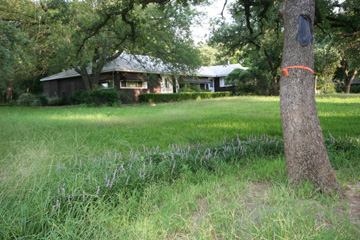 The first warning that trouble was afoot in the Brentwood Oak Hills neighborhood came via the trees. In early May, Jim and Laurie Lawrence noticed that every tree in the front yard of a neighbor’s heavily wooded three-and-a-half-acre lot at 2201 Oak Hill Rd. on the city’s East Side was circled with a red ribbon. The land and the historic 1940s-era house that sits on it had recently been sold, but no new owner had yet moved in. Laurie, the lead science teacher at West Handley Elementary, had worked on the tree ordinance passed by the city last year, so she knew exactly what those ribbons meant: The trees were destined for destruction. The couple and other neighbors walked the property and counted more than 120 ancient post oaks; all were marked. Smaller trees, such as redbuds, were also tagged. Both species are on the list of “protected trees” in the ordinance, which imposes tough and costly regulatory burdens on anyone asking for a permit to cut them. “Some of the post oaks there are more than 200 years old. … I was horrified,” said Laurie, whose four acres are home not only to her and her husband, but also to two horses, three cows, a snake, and numerous dogs and cats. The Lawrences and four of their closest neighbors own properties ranging from two to four acres in an area of rolling hills, wide streets, and well-kept homes. It’s a neighborhood that seems to have mixed its rural heritage seamlessly into its urban environment.
The first warning that trouble was afoot in the Brentwood Oak Hills neighborhood came via the trees. In early May, Jim and Laurie Lawrence noticed that every tree in the front yard of a neighbor’s heavily wooded three-and-a-half-acre lot at 2201 Oak Hill Rd. on the city’s East Side was circled with a red ribbon. The land and the historic 1940s-era house that sits on it had recently been sold, but no new owner had yet moved in. Laurie, the lead science teacher at West Handley Elementary, had worked on the tree ordinance passed by the city last year, so she knew exactly what those ribbons meant: The trees were destined for destruction. The couple and other neighbors walked the property and counted more than 120 ancient post oaks; all were marked. Smaller trees, such as redbuds, were also tagged. Both species are on the list of “protected trees” in the ordinance, which imposes tough and costly regulatory burdens on anyone asking for a permit to cut them. “Some of the post oaks there are more than 200 years old. … I was horrified,” said Laurie, whose four acres are home not only to her and her husband, but also to two horses, three cows, a snake, and numerous dogs and cats. The Lawrences and four of their closest neighbors own properties ranging from two to four acres in an area of rolling hills, wide streets, and well-kept homes. It’s a neighborhood that seems to have mixed its rural heritage seamlessly into its urban environment.
Farm animals coexist with the neighborhood dogs, cats, and kids. And then there is what the homeowners consider their most precious and endangered asset — the urban forest canopy that shelters them all. When the neighbors contacted city hall to find out about the trees, what they learned sent chills up their spines and lit a fire in their bellies. Antonio Caballero, a Dallas housing developer with ties to Mexico City, had bought the property on May 10 and was planning to subdivide it into 18 lots, each 50 by 100 feet, for a development called Villa Estates with a narrow street down the middle named Pancho Villa Lane. By the time the neighbors found out what was happening, the city staff had already approved the preliminary plat. The trees were destined to become firewood if Caballero went forward with his plans, which left no room for old-growth trees in such a small subdivision. Sensing that their way of life and the value of their homes were under threat, but also motivated by the graver threat such a development could bring to the area’s aging infrastructure and well-documented flooding problems, the homeowners quickly mounted a campaign to stop the development. Their battle was carried forward by two neighborhood associations, Brentwood Oak Hills and Eastern Hills, both well known at city hall for their politically and civically active members.
Now those trees may become a major test of the effectiveness of the city’s tree ordinance, which went into effect Jan. 30, as the value of those old oaks — from their canopies’ usefulness in reducing pollution and heat to their roots’ abilities to protect against soil erosion and suck up water from storms, is pitted against the profit interest of a developer who wants to replace the trees with small, individual homes on clear-cut lots. The outcome of this battle may ultimately be decided by a federal judge who has no dog — or jurisdiction — in the fight. Caballero is a twice-convicted felon who is now facing a possible federal prison sentence for defrauding the government. Four months before he bought the Fort Worth property, the developer pleaded guilty in federal district court in Dallas to charges that he lied to the U.S. Department of Housing and Urban Development by failing to tell the agency about a Nov. 18, 1999, felony conviction in order to get approval to become an FHA lender. According to HUD documents, not only did he lie, he provided undocumented immigrants with falsified Social Security numbers allowing them to fraudulently obtain FHA-insured loans to buy homes from him. Court documents show that the latter set of charges were not pursued, based on Caballero’s agreement to cooperate with prosecutors, but he can still be prosecuted for them if he violates “any provision of the [plea] agreement.” HUD lost $400,000 in the scheme that resulted in 11 defaulted mortgages, the agency’s Office of Inspector General reported.
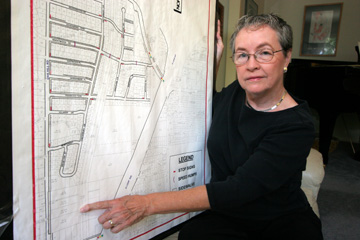 Federal prosecutor Lynn Hastings said sentencing is set for Dec. 3. She said she was prohibited by law from revealing the nature of his former felony. However, records from the Texas Department of Public Safety, as well as those of the Collin County district court, show that a man by the same name and with the same birth date as Caballero was convicted of felony theft of property worth between $1,500 and $20,000 on Nov. 18, 1999 — the conviction date listed in HUD records. No further information on the case was available. Caballero faces a maximum of five years in prison and a $250,000 fine. He also must repay HUD $119,000 before his sentencing. HUD records show that in May, Caballero was suspended indefinitely from doing business with any federal agency. Calls to his office and home and to his attorney asking for comments have not been returned.
Federal prosecutor Lynn Hastings said sentencing is set for Dec. 3. She said she was prohibited by law from revealing the nature of his former felony. However, records from the Texas Department of Public Safety, as well as those of the Collin County district court, show that a man by the same name and with the same birth date as Caballero was convicted of felony theft of property worth between $1,500 and $20,000 on Nov. 18, 1999 — the conviction date listed in HUD records. No further information on the case was available. Caballero faces a maximum of five years in prison and a $250,000 fine. He also must repay HUD $119,000 before his sentencing. HUD records show that in May, Caballero was suspended indefinitely from doing business with any federal agency. Calls to his office and home and to his attorney asking for comments have not been returned.
A housekeeper at his home said last week that the family was in Mexico City. When told that the city staff had approved a housing development by a felon who has admitted defrauding another government entity, City Manager Charles Boswell and Planning Director Fernando Costa expressed shock. But both told Fort Worth Weekly that even if city staffers had known of his conviction at the time they considered the preliminary plat, they were still bound by state law to OK it as long as he met the requirements of the city ordinance and filed all the right paperwork.
The felony conviction would have impact only if Caballero asks for a tax break or for infrastructure help, which he has not yet done, Boswell said. “At that point, we could deny him tax dollars because of the conviction,” he said. “Otherwise the city’s hands are tied. … There is nothing in the law that requires a developer to be honest.” Boswell seemed more disturbed when he heard that the trees had already been tagged. “I’m going to get my people on top of that right away,” he said. “We don’t want him starting to cut those trees on the sly.” Some residents were taken aback by the city’s admitted impotence. “For the city not to care one iota that they are giving permission to [a developer] who has defrauded the federal government … makes me wonder if [city officials have] considered that the info in his plat [application] might also be fraudulent,” resident Gail Giles said. Louis McBee, president of the Eastern Hills Neighborhood Association, said his group is “fighting like mad to … keep the negative impacts of additional development on our sewers and storm water runoff from invading our little tree-covered corner of the city. Unfortunately, we have to fight not just an unscrupulous developer but our own city.” “We don’t have a knee-jerk negative reaction to development out here,” said Rita Vinson, president of the Brentwood Oak Hills Neighborhood Association. She pointed to the association’s endorsement of a low- to moderate-income housing development between Oak Hill Road and Loop 820 known as Crescent Place, a planned subdivision of 77 single-family homes in the $110,000 range. “We supported that project because it seemed that the developer was willing to work with the neighborhoods, and we felt that it would fill a housing need,” she said.
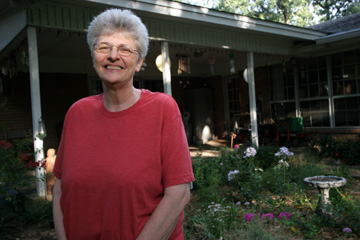 But it didn’t work out as planned, she said. Many of the houses have been empty for more than a year, inviting vandalism and theft. In fact, sales have been so slow at Crescent Place that the developer has built only a fraction of the planned homes, Vinson said. “We think the experience with that project shows there’s not a demand for another similar project in the area,” she said. “The worst thing that could happen is if Caballero gets an OK, cuts the trees, and then walks away after building a house or two because the demand isn’t there. That would be devastating.” “Animals seem to come here and bring their friends,” Laurie Lawrence said of her menagerie. That may be because animals know they’re welcome along her stretch of Oak Hill Road. The Lawrences and their nearby neighbors own properties that were once part of a rural 100-acre estate owned by Fort Worth’s A. Brandt furniture manufacturing family. When the city annexed the area, its rural characteristics were grandfathered, allowing future owners to keep large and small farm animals. The sounds of horses neighing and roosters crowing at dawn have been part of its ambiance and charm ever since, residents say. Even more important to them, however, is the extensive canopy of old-growth trees that covers the comfortable, middle-class neighborhoods that grew up around the Brandt property: Brentwood Oak Hills on the east side of Oak Hill Road and Eastern Hills on the west. The area is bounded by Meadowbrook Drive on the south, Brentwood Stair on the north, Loop 820 to the east, and the Meadowbrook municipal golf course on the west.
But it didn’t work out as planned, she said. Many of the houses have been empty for more than a year, inviting vandalism and theft. In fact, sales have been so slow at Crescent Place that the developer has built only a fraction of the planned homes, Vinson said. “We think the experience with that project shows there’s not a demand for another similar project in the area,” she said. “The worst thing that could happen is if Caballero gets an OK, cuts the trees, and then walks away after building a house or two because the demand isn’t there. That would be devastating.” “Animals seem to come here and bring their friends,” Laurie Lawrence said of her menagerie. That may be because animals know they’re welcome along her stretch of Oak Hill Road. The Lawrences and their nearby neighbors own properties that were once part of a rural 100-acre estate owned by Fort Worth’s A. Brandt furniture manufacturing family. When the city annexed the area, its rural characteristics were grandfathered, allowing future owners to keep large and small farm animals. The sounds of horses neighing and roosters crowing at dawn have been part of its ambiance and charm ever since, residents say. Even more important to them, however, is the extensive canopy of old-growth trees that covers the comfortable, middle-class neighborhoods that grew up around the Brandt property: Brentwood Oak Hills on the east side of Oak Hill Road and Eastern Hills on the west. The area is bounded by Meadowbrook Drive on the south, Brentwood Stair on the north, Loop 820 to the east, and the Meadowbrook municipal golf course on the west.
Several of the residents, including science teacher Lawrence, worked with last year’s citizen task force to develop the city’s first ordinance written to preserve the city’s trees. Tobi Jackson, a long-time area resident and member of the city’s Parks and Community Services Board, who spoke to the Weekly as a private citizen, said that their input was vital for the preservation of the area’s old-growth post oaks and blackjack oaks. Such trees are traditionally smaller than other ancient trees and are often considered insignificant for that reason. However, due to the Eastside citizens’ efforts, the area’s oaks were given special protected status in the ordinance because of their ecological significance as part of the original Post Oak Savannahs ecological niche within Fort Worth’s larger Cross Timbers Zone. Lawrence has made the tree-preservation effort part of her science teaching projects, motivating students to write dozens of letters to city hall, including those quoted from above. Once the ribbons were discovered on such a large number of protected trees, Lawrence and others called Kenny Sims, one of the city’s two urban forest compliance officers, whose job it is to enforce the tree ordinance. Sims came out and took pictures of the tagged trees, but he said there is nothing further he can do until the developer makes a formal application to remove the trees, which he has not yet done.
The house and acreage, valued at $151,000 on the county tax rolls, had been for sale for some time, but neighbors just figured the buyer would be a family interested in maintaining the integrity of the neighborhood, said Michelle Richardson, who lives four doors north of the property in one of the Brandt sons’ homes that she and her husband Charles Rose are remodeling. “We’ve spent $100,000 so far, but we’ve put everything on hold ’til this plays out,” she said. “We don’t want to put another hundred grand into it if the place is going to lose its value.” Instead of a family moving in at 2201 Oak Hill Rd., Richardson and her neighbors found that the owners, James and Sue Zebell, had sold the house and acreage on May 9 to a real estate company, Metro Holdings of Dallas, which immediately flipped the property, selling it the next day to Caballero, owner of American International Homes, Inc. and American International Finance and Mortgage Services. James Zebell said he had no idea the house would wind up in the hands of a developer. “We sold to a real estate investment company. We thought it would be sold to someone who would remodel it. … We loved that property,” he said. Zebell said he was told more than a year ago that the house qualified for designation as one of Fort Worth’s historical homes due to its age and connection to the Brandt family. “Destroying it would be horrible,” he said. Zebell would not reveal his sale price, but a real estate web site that listed the property for Metro Holdings showed a price tag of $225,000. When asked about the listing, Zebell said only, “If Metro got that, then they made a nice profit.”
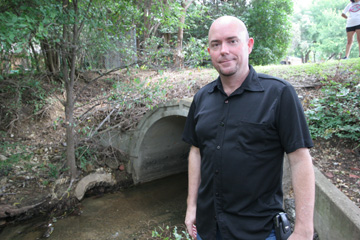 By May 29, Caballero’s intent was clear. That day, Brentwood Hills neighborhood association president Vinson was notified by the city that the developer had filed an application to subdivide the property in order to build 18 homes, to sell for about $110,000. The city staff’s review “found nothing to keep them from approving” the preliminary plat, the notice read. When the plat plan went before the Fort Worth Plan Commission in late June, a delegation from Brentwood Oak Hills and Eastern Hills, led by Vinson, McBee, and former Eastern Hills president Jeff Robinson, showed up to protest. They based their objections on the impact the development would have on the neighborhoods’ aging infrastructure and already severe flooding and sewage overflow problems, as well as traffic. “We knew we weren’t going to get anywhere arguing simply for the aesthetic value of the trees,” said Vinson, who has become a leading spokeswoman for the two groups. “We had to show that this area simply couldn’t accommodate the increased traffic and the burden that 18 more homes on treeless lots would put on the water, sewage, and storm drainage systems.” Robinson, who lives on Monterrey Drive, downhill from Oak Hill Road, said, “We’ll get all the water from that development, and we can’t handle any more.”
By May 29, Caballero’s intent was clear. That day, Brentwood Hills neighborhood association president Vinson was notified by the city that the developer had filed an application to subdivide the property in order to build 18 homes, to sell for about $110,000. The city staff’s review “found nothing to keep them from approving” the preliminary plat, the notice read. When the plat plan went before the Fort Worth Plan Commission in late June, a delegation from Brentwood Oak Hills and Eastern Hills, led by Vinson, McBee, and former Eastern Hills president Jeff Robinson, showed up to protest. They based their objections on the impact the development would have on the neighborhoods’ aging infrastructure and already severe flooding and sewage overflow problems, as well as traffic. “We knew we weren’t going to get anywhere arguing simply for the aesthetic value of the trees,” said Vinson, who has become a leading spokeswoman for the two groups. “We had to show that this area simply couldn’t accommodate the increased traffic and the burden that 18 more homes on treeless lots would put on the water, sewage, and storm drainage systems.” Robinson, who lives on Monterrey Drive, downhill from Oak Hill Road, said, “We’ll get all the water from that development, and we can’t handle any more.”
At a residents’ meeting in July at the home of Carol Eicher, who lives on the west side of Oak Hill Road about a block from the planned development, guests had to step over sand bags she had placed near her porch to divert the flood water that filled her yard following a heavy downpour earlier in the day. “Sandbagging my front yard has become part of my yard work when it rains,” she said. By the time of the Plan Commission hearing, residents had done their homework. McBee, Vinson, and Robinson presented a packet filled with years of infrastructure horror stories for which the community had sought help from a mostly deaf city hall. They included the city’s own 2003 engineering studies, showing the inadequacy of drainage systems in the area. (Strangely enough, Vinson said, the city engineer who was reviewing the case for the planning commission was “totally unaware of the 2003 study. … I was shocked at how little the left hand at city hall knows what the right hand is doing.”) The 2003 study said that replacement and upgrading of the system for just eight streets and cleaning out a clogged culvert would cost the city more than $2.6 million. But Vinson and Robinson said that so far the city has spent only about $215,000 of $12 million set aside in the 2004 bond election for the East Side’s drainage and sewage problems.
The city has fixed two blocks each on three streets, Vinson said. “Now, instead of following through on the 2003 study, the city is doing yet another study, claiming the first one was only preliminary,” she said. “Who knows when we will get anything done out here?”
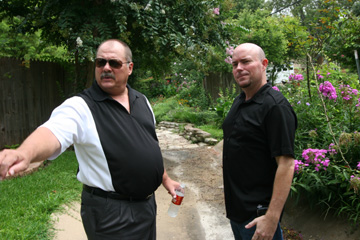 Residents also showed the commission pictures from the city’s underground cameras of broken and grease-encrusted clay sewage pipes in the affected neighborhoods. There were pictures of flooded streets following large and small rainstorms. And they presented letters from dozens of residents documenting everything from regularly occurring backups of raw sewage near homes and schools to flooding at the confluence of the area’s two storm water drainage basins downhill from Oak Hill Road — flooding that has been severe enough to put as much as two feet of flood water into residents’ garages after just normal rains. “The problem is so pronounced that one … owner has built a masonry wall around the perimeter of his property to offer protection from the storm water,” the city’s engineering study noted. Robinson told the commission that the current storm drainage system “was not designed for the amount of runoff due to the high amount of area that has been developed and paved over” during the years. “Our concern is that any additional development … will drastically affect our residents [and] our property values and potentially place the city at risk of class action litigation … for problems known to the city in advance” but never corrected, he said. He talked about the “worn-out sewer system,” citing problems as recent as the week of June 18, when the city had to pump raw sewage out of a creek in his neighborhood.
Residents also showed the commission pictures from the city’s underground cameras of broken and grease-encrusted clay sewage pipes in the affected neighborhoods. There were pictures of flooded streets following large and small rainstorms. And they presented letters from dozens of residents documenting everything from regularly occurring backups of raw sewage near homes and schools to flooding at the confluence of the area’s two storm water drainage basins downhill from Oak Hill Road — flooding that has been severe enough to put as much as two feet of flood water into residents’ garages after just normal rains. “The problem is so pronounced that one … owner has built a masonry wall around the perimeter of his property to offer protection from the storm water,” the city’s engineering study noted. Robinson told the commission that the current storm drainage system “was not designed for the amount of runoff due to the high amount of area that has been developed and paved over” during the years. “Our concern is that any additional development … will drastically affect our residents [and] our property values and potentially place the city at risk of class action litigation … for problems known to the city in advance” but never corrected, he said. He talked about the “worn-out sewer system,” citing problems as recent as the week of June 18, when the city had to pump raw sewage out of a creek in his neighborhood.
Increased traffic was cited as another serious concern. Jackson pointed out that three schools housing about 1,800 students are within two blocks of the proposed development. “We [already] have severe traffic issues on Oak Hill Road, specifically during the school year,” she wrote. Adding 18 homes with their only street exiting onto Oak Hill “will increase the traffic flow and congestion on an already overloaded major thoroughfare …. .” Lawrence appealed on behalf of the trees — not for their beauty but for their beneficial effects on the environment. “One acre of mature trees can absorb the [carbon dioxide] of one car driven 26,000 miles annually,” she wrote in a letter presented to the commission. “Land with fibrous-rooted systems absorbs runoff 127 percent faster than bare ground.” But she also wants to preserve the value of her home, she said. “We have spent the last three years and well over $200,000 renovating and restoring this beautiful site. … We have invested our … life’s savings … and future retirement in preserving the integrity of [the] East Side.” A dozen residents who live directly downhill from the planned development signed a letter to the commission detailing the “significant water damage to residents’ foundations and sewer lines,” from an already inadequate infrastructure. “More concrete and paved areas will do nothing but veer storm waters onward to their destination at the low end” of the neighborhood, the letter said.
Caballero wasn’t present. His engineering consultant, Victor Mujasia of Witherspoon Consulting Engineers of Arlington, spoke for him. In spite of the citizens’ impassioned remarks, Mujasia told the commission that he had heard no opposition to the plan. He said that Caballero planned to put in a detention pond to take care of the storm-water runoff that might occur from the removal of the trees. (Such a pond, designed to hold water temporarily while slowly draining it to another location, would be opposed by the residents, Lawrence said, as “dangerous for the kids in the neighborhood and a breeding ground for mosquitoes.”) Other than the pond, the development would be built as planned, Mujasia said. He did not return the Weekly’s calls to his office. The commission voted six to three in favor of the developer. Vinson and McBee immediately filed an appeal, only to be shot down again. They were told by deputy planning director Dana Burghdoff that the city ordinance had recently been amended to reflect state law that now allows only the applicant for a plat change to appeal a planning commission decision. “How unfair is that?” McBee said. “It is beyond reason that hundreds of citizens have less power under this law than one developer.”
The group has now asked the city council for a zoning change that would, among other things, restrict further development along Oak Hill Road and a stretch of Meadowbrook Drive to single-family homes on lots of one-half acre to one acre, in order to halt Caballero or other developers from buying nearby properties for similar developments. Eastside councilman Danny Scarth said he would support the zoning change, Vinson said. Scarth, however, refused to answer a reporter’s questions, writing in an e-mail, “I do not give interviews to FW Weekly.” There are other hurdles Caballero must jump before he gets a green light from the city to proceed, and all involve money — big money. State law requires a developer to provide a surety bond guaranteeing that claims against the development will be met if the developer defaults. Caballero will also have to pay 100 percent of the cost of the infrastructure for the project up front, said planning department staffer Teresa Burk. And then there’s that pesky tree ordinance. If he goes forward with his plans to clear-cut the acreage in order to cram 18 houses and a tiny street onto it, it could cost him hundreds of thousands of dollars.
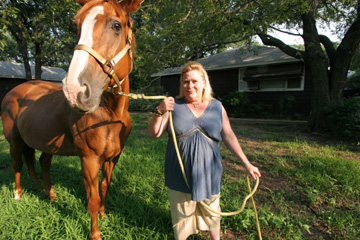 The ordinance, designed to achieve a 40 percent canopy coverage for residential areas and to preserve the existing canopy coverage of significant (very old and very large) “protected” trees throughout the city, specifically includes the urban forests of post oaks and blackjack oaks east of I-35 in that protection. Such trees can be removed only by permit of the city forester, under stringent regulations that require either retention of large areas of the remaining trees, replacing trees by a ratio of five to one, or making payments to the tree fund equal to $200 per diameter inch of each tree cut. Penalties are steep for anyone who violates the ordinance — up to $400 per diameter inch for “significant” trees in addition to a $500 fine per protected tree regardless of size. Caballero’s plat does not allow much room for replacement trees. And the street he plans to cut through the middle of the property will “take out a large number of the biggest trees,” said Michelle Richardson, who helped document the trees on that property.
The ordinance, designed to achieve a 40 percent canopy coverage for residential areas and to preserve the existing canopy coverage of significant (very old and very large) “protected” trees throughout the city, specifically includes the urban forests of post oaks and blackjack oaks east of I-35 in that protection. Such trees can be removed only by permit of the city forester, under stringent regulations that require either retention of large areas of the remaining trees, replacing trees by a ratio of five to one, or making payments to the tree fund equal to $200 per diameter inch of each tree cut. Penalties are steep for anyone who violates the ordinance — up to $400 per diameter inch for “significant” trees in addition to a $500 fine per protected tree regardless of size. Caballero’s plat does not allow much room for replacement trees. And the street he plans to cut through the middle of the property will “take out a large number of the biggest trees,” said Michelle Richardson, who helped document the trees on that property.
The trees designated “significant” under the ordinance are the most costly, she said, and there are more than 20 of those on the property, with circumferences of more than 63 inches. Most of the rest are more than 30 inches, she said, which for some post oaks is also considered “significant” because a post oak’s size does not always indicate its age. Even smaller ones can be 200 years old, she said. The property is “a pristine post oak savannah,” Richardson said. “It will be very costly for Mr. Caballero to cut those trees.”











